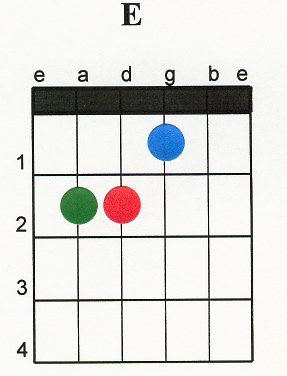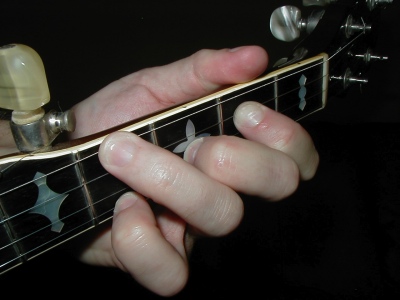
Knowledge of Theory Helps to Build Chords
When an aspiring musician buys their first banjo, guitar or mandolin, they also usually are talked into buying a pictionary chord book. Such a book, lists chord after chord, in charts that are in alphabetically order. Without knowing any better, each time the student comes across an unfamiliar chord in a song, he or she scans the book in an attempt to find the correct chord position on the fingerboard. To learn chords in this manner can be equated to memorizing phone numbers in a phone book.
As a teacher, I advise all my students that the best way to learn chord structure and build a “chord vocabulary” is to begin with basic music theory. This theoretical knowledge begins with understanding the major scale. The major scale (Do, Re, Mi, Fa, Sol, La, Ti, Do) is the backbone of music. It establishes a foundation for a musician to play and understand chords, building melody lines and playing songs.
There are many types of chords and whether or not you use them will depend on the genre of music you play. Unfortunately, some students of the banjo, guitar and mandolin only scrape the surface when studying chord structure. Maybe they learn their open major chords and a handful of minors. Open chords are partially fretted but use open strings as well. Closed forms take the open chords further by moving them up the neck by barring the open strings. Sadly, some students never learn their moveable chord forms up the neck on their instrument.

Finger Strength & Coordination Helps to Build Chords
Studying chords is a process in itself. You can start with a basic understanding that the major chord is built on the first, third and fifth note of the chord’s major scale. The minor is achieve by modifying the major chord with a flatted third. Other chord forms are derived from these chord types and are termed extended or altered chords. Most importantly, the process begins with a basic understanding of the major scale and what notes make up a major chord.
In the future, instead of referring to that pictionary book of chord charts each time you come across a new chord in a song, turn your attention towards basic music theory. Your efforts will be rewarded and you will come out ahead in the long term.

So true! However I find it a lot easier to do this with the mandolin than the guitar…and my mando “chord vocab” is less than my guitar “chord vocab”…go figure!
This is timely info. I think we get all excited about learning specific songs, and spend little to no time learning how they are structured. I think great players of fretted instruments understand scales, and are able to improvise given their knowledge of the foundational basics. I appreciate Dave’s willingness to hammer on the theory, vs. just simple memorizing of chord structure.
I agree with you more than thoroughly… just memorizing chords is plain useless. It’s so much more fun, useful, and empowering to understand the theory behind them, the tonal relationships that define tonal music. Then you can move beyond the commonplace…
I think it really depends on your own perception of what your playing and what style you’ll be creating as you learn and get better. But in the end, I believe that every aspiring fret player must learn basic theory even if afterward they choose to go their own intuitive route with the rest of their playing. Some of us feel we need to stick to theory the entire lifetime we play. Others feel they are better with a balance of just basic theory and intuitive creation.
So many of these books are strictly for beginners who will never be able to think in “music” until they get rid of the crutches.
I AM STILL TRYING TO REMEMBER WHERE THE ROOT AND III, V NOTES ARE LOCATED IN THE THREE MAJOR BANJO CHORD SHAPES. AND THEN HOW TO ADJUST THAT SHAPE TO GET THE MINOR III.
I’m not a banjo player but, if you want to find the root, third, and fifth on a stringed instrument it’s probably the same as any stringed instrument. To find them I start on the same string that I start the root and follow the major scale: root-whole step(2 frets)-whole step-half step(1 fret)-whole step-whole step-whole step-half step which is the major scale. In this case of finding the 3rd and 5th it will be ROOT(I)-whole step- WHOLE STEP(III)-whole step-WHOLE STEP(V). Once I find those notes I remember them and listen for them in my chord. I’ll then flat the third and that makes the chord a minor. However, it may be very inconvenient to play that chord that way so I may have to figure out a way to play those notes using a different position on the neck (that’s your question) but, at least I can find the first, third and fifth. In a normal chord(meaning the root is the lowest note[sound-wise] the 3rd is(again, usually) the next note higher from the root. On the guitar , if I’m playing a C major chord in first position and I have to go to a C minor it is difficult to flatten the third and still keep rythm because of fingering so I’ll barr the neck on the third fret(where my C is located) which is easier and quicker for me and fret the appropriate notes that way. It’s easier for me to do that and not lose a beat. Sometimes spending a few minutes trying to figure it out I find it educational and rewarding to just “go through the process” of trying to figure out a chord whether I’m successful or not. Take a C7 for instance. To play a C7 chord you need to play the 7th note of the chord. The seventh in a C major chord is a B. Playing a B next to a C by a 1/2 step would sound awful(and next to impossible) so, to play that I have to find a B in the higher notes so it doesn’t sound dissonant(bad). In this case it’s easily done with my pinky 3rd str/3rd frt.
It’s very frustrating. So far I understand that there are three forms, and major chords contain a 1-3-5 on the banjo. And there you have it! Am I the only one having trouble grasping this?
Unless you are superb at rote memorization and can incorpate that into your playing, knowing how to make chords is a must. Sudently all the majors, minor augmented, diminshed, suspended, 7, Major 7 etc. start to make sense. You just have to memorize what notes make up those chords but you can construct them yourself without a crutch.
With this knowlege you should be able to make any chord, even if you are stranded on a desert island. BTW, be sure to bring your intrument to the island. This is all about knowing your way around the fretboard.
This information is particularly timely now, as I’ve been working on Christmas songs which seem to branch out beyond the typical chord structure (i.e. G, D, C, etc…). F sharp diminished???? I mean, come on!! I’m starting to see that understanding the basic chord structure (relation of the root, III and IV to each other) is actually easier to remember to make diminished, minor or augmented chords (I don’t even pretend to understand 7 chords yet) than trying to remember 4 or 5 different versions of each chord. However, learning how to make bar forms that actually sound halfway decent is taking forever.
Uh oh Fretmentor….I’ll have to find something different to offer as a raffle prize!